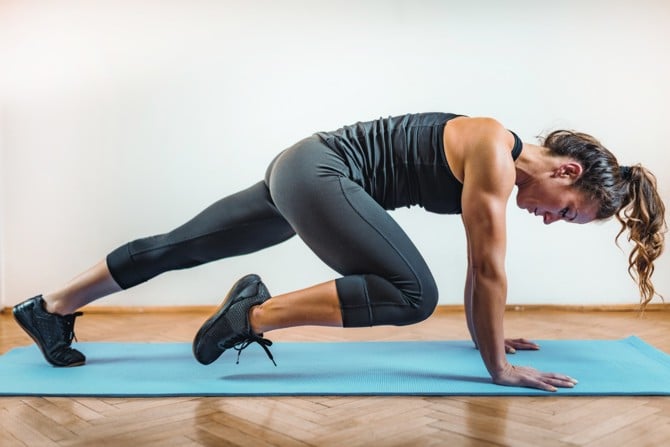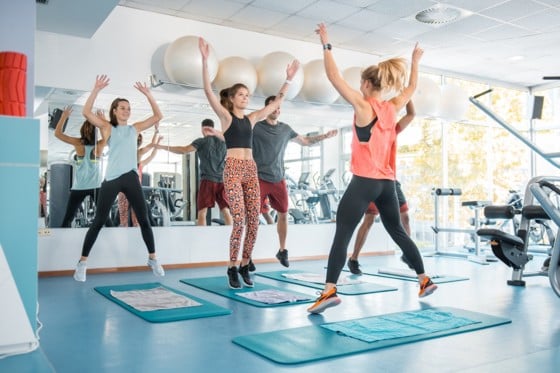Interval Training: from HIIT to Tabata
The best exercises for beginners and advanced users

HIIT or Tabata - what is it and how does interval training work? We answer the most important questions about the fitness trend and introduce you to exercises for beginners and advanced users.
- What is interval training?
- HIIT – high intensity interval training
- Interval training FAQs
- How often should you do interval training?
- How long should a training session be?
- Is interval training good for building muscle?
- Is interval training good for endurance training?
- Is HIIT meant for everyone?
- HIIT training at home
What is interval training?
In interval training, exercises are performed at a certain rhythm and interspersed with breaks. The aim is to organise the breaks in such a way that the body cannot fully recover, thereby training endurance, speed and strength. There are special interval training programs for interval training for running or road cycling. However, interval training can also be carried out as general fitness training. High-intensity interval training, or HIIT for short, is particularly well-known and popular.
HIIT - high-intensity interval training
When we talk about interval training, most people probably think of HIIT, or High Intensity Interval Training. The workout consists of intensive exertion phases that alternate with recovery phases, as with other interval training programs. The aim of the training concept is to push the body to its limits, thereby training strength and endurance and burning fat.
Last but not least, HIIT has also become popular in recent years due to the short time required. Regular endurance training, for example, is based on a long training period with low intensity. HIIT, on the other hand, is much quicker. It consists of a short training period at maximum intensity. This sounds like the perfect workout for anyone who wants to optimize their fitness alongside their office job. And you don't need a gym membership or equipment to get started with HIIT.
However, HIIT is not just HIIT - there are various training methods that utilise the HIIT concept. We tell you what Tabata, the Little Method and Turbulence Training are all about.

Tabata
Tabata is an increasingly popular variant of HIIT training that developed from a study published in 1996 by Professor Izumi Tabata, a researcher at the National Institute of Fitness and Sports in Tokyo. Olympic speed skaters trained according to the Tabata training program, which consists of 20 seconds of high exertion followed by 10 seconds of rest in eight rounds. The result of the study was that the athletes' anaerobic performance (muscles working without oxygen supply) increased. Due to the very fast sequence of exercises, Tabata is suitable for anyone who already has experience with HIIT and can perform the exercises properly.
Craving a workout? Here's one of our favorites:
Little Method
The Little method is also a form of HIIT training. The workout was named after Dr Jonathan P. Little and consists of exercise phases of 60 seconds and recovery phases of 75 seconds. The intervals are repeated 12 times. The Little method offers a challenging workout for which you should have a certain basic level of fitness, as the 60-second exercise phases take a long time.
Turbulence Training
In turbulence training, you start with a strength exercise that you repeat slowly eight to ten times. You then perform a high-intensity cardio exercise for one minute. The intervals can be repeated as often as possible. Turbulence training can be a good introduction to HIIT training, as you repeat the strength exercise slowly and learn how to perform it correctly.

Frequently asked questions about interval training
How often should I train and how does HIIT improve my endurance? We answer the most important questions about HIIT training.
How often should you do interval training?
Interval training, such as HIIT training, challenges the body. You should therefore not train more than two to three times a week so that you can maintain a recovery time of 24 to 72 hours. Otherwise, as with classic fitness training, there is a risk of overtraining.
How long should an interval training session be?
Brevity is the spice of fitness. The duration of interval training depends on the respective workout:
- An average HIIT training session lasts a maximum of 20 minutes.
- Tabata training only takes around 4 minutes.
- Little Method training usually lasts 27 minutes.
- You need to invest around 45 minutes for turbulence training
Five to ten minutes can be added to the training times for warming up and cooling down.
Is interval training like HIIT good for building muscle?
The high intensity of strength training with your own body weight or extra weights can stimulate muscle growth, as it triggers hormonal and therefore anabolic reactions (build-up of endogenous substances or tissue, as well as muscles) in the body. However, it is important that you do not do classic endurance training too intensively alongside HIIT training. This is because prolonged endurance training has a catabolic effect on the body. This means that it supports the breakdown of energy-supplying nutrients and can therefore stop muscle building.
Is interval training such as HIIT good for endurance?
According to the latest research in sports science, HIIT has a positive effect on performance and therefore also on endurance. According to Christian Manunzio from the Cologne Sports University, interval training in various sports is said to boost endurance ten times more effectively than other methods.
Is HIIT suitable for everyone?
Into your training shoes and onto the fitness mat? Not so fast. HIIT may promise a lot, but it can also put a strain on the body and mind. The experience of HIIT workouts can be compared to moderate endurance training.
The risk of injury is also an issue with interval training such as HIIT. The workout can put a lot of strain on the knees in particular. It is particularly important that you perform all exercises correctly. However, not everyone has the flexibility, muscle or core strength for this. Therefore, start with less intensive exercises and plan enough recovery time.

HIIT training at home
Enough with the HIIT theory, now it's time to train. We present a selection of exercises for beginners and advanced users that you can use to train easily at home.
Warm up
Start every HIIT workout with a warm up. This gets your blood circulation going and prepares your body for the exercise. You can perform the following exercises:
- Running in place
- Thoracic spine rotation
- Hip extension
10 exercises for beginners and intermediate
Are you warmed up? Then you can start with the HIIT exercises now.
For beginners we recommend the following plan:
- 15 to 20 seconds of stress, 30 seconds pause, repeat. 10 minutes in total
Intermediates can try out this plan:
- 30 seconds of activity, 60 second break. In total 20 minutes.
Keep your risk of injury as low as possible by performing all exercises correctly.
You don't need any equipment or weights for the interval training exercises, just a fitness mat.
Beginners
The following five HIIT exercises are good for beginners as they are not too complex and help to build strength and endurance.
Jumping Jacks
Jumping jacks, also known as jumping jacks, are a classic in sports lessons. And with good reason: they challenge the leg muscles, stimulate blood circulation and train arm-leg coordination.
You can see how to do jumping jacks correctly in the following video:
Incline Push-ups
Push-ups are an integral part of HIIT training. However, it is particularly important that the technique is right. If you don't yet have enough strength for 'normal' push-ups, the incline variation is a good alternative. For this exercise, you don't place your hands on the floor, but on a raised object such as a bench.
This video gives tips on how to do this correctly:
Plank
If you want to train with HIIT, you can't avoid the plank, also known as the forearm plank. The exercise trains the whole body, with a focus on the core muscles.
The following video shows you how to plank correctly.
Lunges
After planking, lunges are another basic exercise in interval training. They are the basis for all exercises that put more strain on the knees and legs.
This video shows what is important in the execution:
Squats
Squats are also a basic exercise for any HIIT workout. You can use them to train your legs and bottom. But be careful: Squats look easy, but they are often done incorrectly, to the detriment of the knees.
The following how-to video shows what is important when doing squats:
Advanced
Simple planks, lunges or squats are no challenge for you? Then you can try the following HIIT exercises for advanced users.
Russian Twist (with raised legs)
The Russian twist trains your lateral abdominal muscles. It is particularly intense if you lift your legs off the floor.
The following video explains the correct form:
Burpees
An exercise that trains the whole body and brings even fitness pros to their knees: burpees. But you can only train effectively with the mixture of squats, press-ups and stretch jumps if you pay attention to the correct execution and body tension.
This guide shows you how to do it properly:
Jump Squats
Have you mastered the 'normal' squats? Then it's time for jump squats. This exercise not only trains your leg and bottom muscles, but also your endurance thanks to the jumping.
You can find tips on how to do them correctly here:
Mountain Climbers
Like burpees, mountain climbers are a full-body exercise that packs a punch. You need sufficient body tension for the combination of push-ups and alternating jumps.
This video shows you what is important when performing the exercise:
Diamond Push-ups
Demanding, more demanding, most demanding - that's what Diamond Push-ups are. Instead of just "simply" doing push-ups, diamond push-ups involve bringing your hands closer together. The result: the exercise becomes more intense and the back of the arms are put under greater strain
The following video shows you how to perform the diamond push-ups correctly:
Cool Down
Congratulations, you have completed your HIIT exercises. A cool down is now waiting for you as a reward. The "cool down" after the interval training is important so that your cardiovascular system stabilizes again and the muscles are relieved after the heavy strain. The following exercises can help with this.
- Stretching the thigh muscles
- Shoulder mobilization
- Breathing in supine position
Mirco from HIIT Together presents a selection of cool-down exercises:
For more fitness
Perhaps you have already found the right fitness program for you with HIIT training and HIIT exercises. If not, we recommend that you try out different workouts. How about calisthenics or a fitness app for example? For even more fitness knowledge and tips, we also recommend the following magazine articles:
Image Credits: Title image: microgen/gettyimages, image 2: Geber86/gettyimages, image 3: kovaciclea/gettyimages, image 4: Nattakorn Maneerat/gettyimages